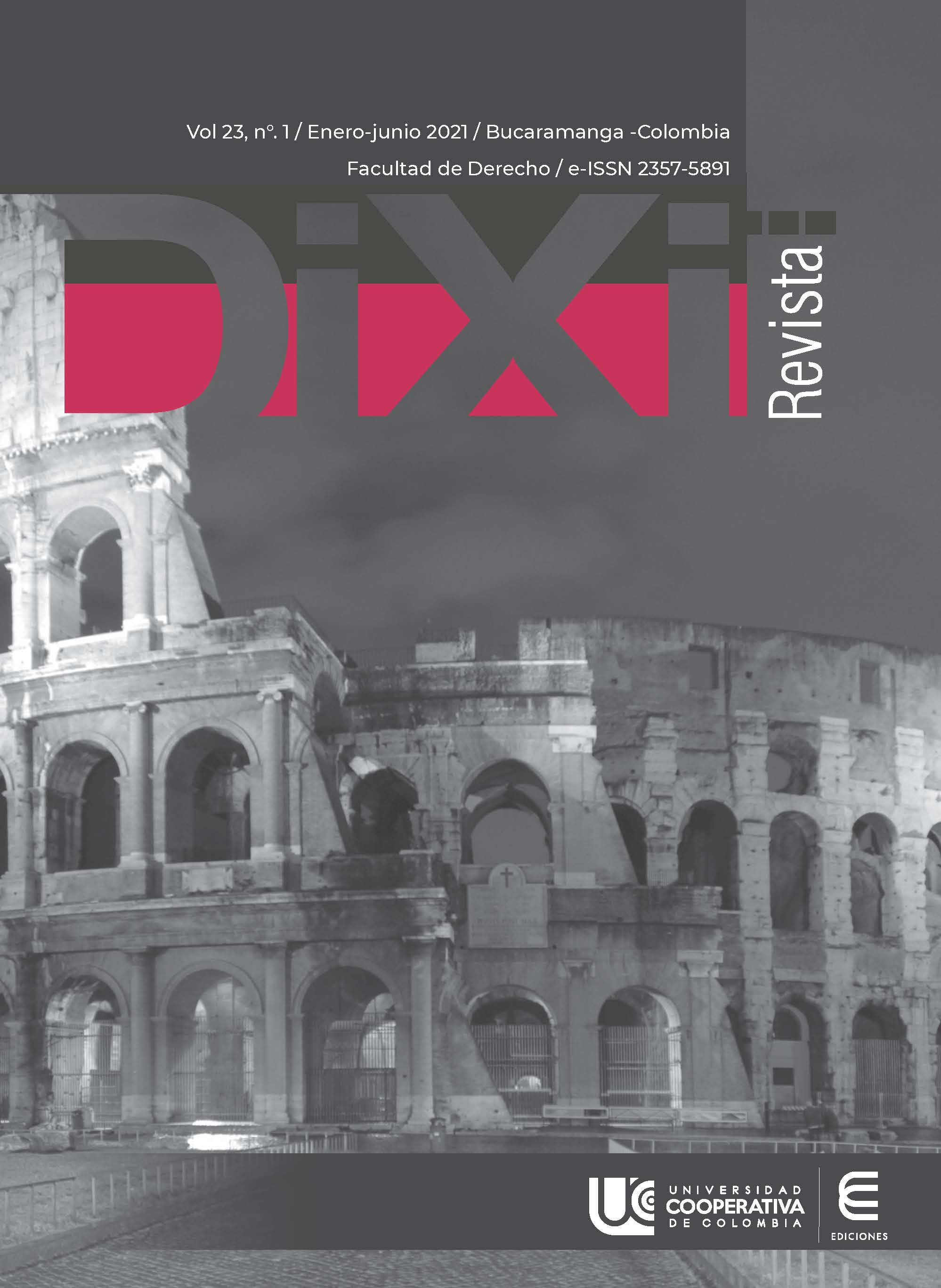Un recorrido por las fuentes de la lex informatica
Objetivo: los escasos desarrollos normativos a nivel internacional y las iniciativas relativas a la armonización del derecho en el ámbito electrónico hacen necesaria su disciplina jurídica singular. El objetivo de este escrito busca identificar las fuentes de la denominada lex informatica.
Metodología: el estudio parte de la definición de lex informática, luego se centra en las formas de regulación alternativa aplicadas al derecho informático y finaliza con la sistematización de las categorías sobre las cuales se podría edificar esta nueva disciplina.
Conclusión: la investigación permite concluir que ante la necesidad de una reglamentación apropiada se explore la posibilidad de que sean las entidades públicas y privadas las que interactúen a través del esquema de la corregulación en la consolidación de ese cuerpo normativo y que mientras eso ocurra, se continúe acudiendo a la costumbre y los principios generales del derecho para su desarrollo.
Cómo citar
Licencia
Derechos de autor 2021 DIXI

Esta obra está bajo una licencia internacional Creative Commons Atribución 4.0.
Every single author of the articles has to declare that is an original unpublished work exclusively created by them, that it has not been submitted for simultaneous evaluation by another publication and that there is no impediment of any kind for concession of the rights provided for in the contract.
In this sense, the authors committed to await the result of the evaluation by the journal DIXI before considering its submission to another medium; in case the response by that publication is positive, additionally, the authors committed to respond for any action involving claims, plagiarism or any other kind of claim that could be made by third parties.
At the same time, the authors have to declare that they are completely in agreement with the conditions presented in their work and that they cede all patrimonial rights. These rights involve reproduction, public communication, distribution, dissemination, transformation, making it available and all forms of exploitation of the work using any medium or procedure, during the term of the legal protection of the work and in every country in the world, to the Universidad Cooperativa de Colombia Press.
Arnon Mefford. Lex Informatica: Foundations of Law on the Internet. INDIANA JOURNAL OF GLOBAL LEGAL STUDIES 1. 1997. Disponible en: https://www.repository.law.indiana.edu/ijgls/vol5/iss1/11
Antonis Patrikios. Resolution of Cross-Border E-Business Disputes by Arbitration Tribunals on the Basis of Transnational Substantive Rules of Law and E-Business Usages: The Emergence of the Lex Informatica. THE UNIVERSITY OF TOLEDO LAW REVIEW 1. 2006.
Comisión de las Naciones Unidas para el Derecho Mercantil. LEY MODELO CNUDMI SOBRE COMERCIO ELECTRÓNICO 1996. Naciones Unidas. (1999). Disponible en: https://www.uncitral.org/pdf/spanish/texts/electcom/05-89453_S_Ebook.pdf
Comisión de las Naciones Unidas para el Derecho Mercantil. LEY MODELO CNUDMI SOBRE FIRMAS ELECTRÓNICAS 2001. Naciones Unidas. (2002). Disponible en: https://www.uncitral.org/pdf/spanish/texts/electcom/ml-elecsig-s.pdf
Comisión de las Naciones Unidas para el Derecho Mercantil. LEY MODELO CNUDMI SOBRE UTILIZACIÓN DE LAS COMUNICACIONES ELECTRÓNICAS EN LOS CONTRATOS INTERNACIONALES 2005. Naciones Unidas (2007). Disponible en: https://www.uncitral.org/pdf/spanish/texts/electcom/06-57455_Ebook.pdf
Comisión de las Naciones Unidas para el Derecho Mercantil. LEY MODELO CNUDMI SOBRE ARBITRAJE COMERCIAL INTERNACIONAL 1985, CON LAS ENMIENDAS APROBADAS EN 2006. Naciones Unidas. (2008). Disponible en: https://www.uncitral.org/pdf/spanish/texts/arbitration/ml-arb/07-87001_Ebook.pdf
Corte Internacional de Justicia (CIJ). Estatuto de la Corte Internacional de Justicia. 1945. Disponible en: https://www.un.org/es/documents/icjstatute/
Daniel J. Ryan, Maeve Dion, Eneken Tikk y Julie J. C. H. Ryan. International Cyberlaw: A Normative Approach. GEORGETOWN JOURNAL OF INTERNATIONAL LAW 42. 2011. Pág. 1161-1199.
Dimitrios Koukiadis. RECONSTITUTING INTERNET NORMATIVITY: THE ROLE OF STATE, PRIVATE ACTORS, GLOBAL ONLINE COMMUNITY IN THE PRODUCTION OF LEGAL NORMS. Nomos Verlagsgesellschaft. (2015).
Edward Best. Alternative Regulations or Complementary Methods? Evolving Options in European Governance. EIPASCOPE 1. 2003.
Emilio Suñé Llinás. DECLARACIÓN DE DERECHOS DEL CIBERESPACIO. INFORMÁTICA JURÍDICA Y DERECHO DE LA INFORMÁTICA.
Editorial Universidad Complutense de Madrid. (2009). Disponible en: https://oiprodat.com/2013/04/22/constitucion-del-ciberespacio/
International Chamber of Commerce (ICC). General Usage for International Digitally Ensured Commerce. 1997. Disponible en: https://cryptome.org/jya/guidec2.htm
International Chamber of Commerce (ICC). ICC guide for E-Contracting. 2004. Disponible en: https://www.iccwbo.org/products-and-services/trade-facilitation/tools-for-e-business/Jean-Francois Lerouge. Internet Effective Rules: The Role of Self-Regulation. KLUWER LAW INTERNATIONAL 8. 2001. Pág. 199.
Karim Benyekhelf, Vincent Gautrais y Guy Lefebvre. Droit du commerce électronique et normes Applicables: L’émergence de la Lex Electronica = Electronic Commerce Law and Applicable Norms: The Emergence of the Lex Electronica. INTERNATIONAL BUSINESS LAW JOURNAL 5. 1997.
Linda Senden. Soft Law, Self-Regulation and Co-Regulation in European Law: Where Do They Meet? ELECTRONIC JOURNAL OF COMPARATIVE LAW 1. 2005. Disponible en: https://ec.europa.eu/digital-single-market/sites/digital-agenda/files/discussions/Soft%20Law,%20Self-Regulation%20and%20Co-Regulation%20in%20European%20Law-Where%20do%20they%20meet.pdf
Martha Lucía Neme. Buena fe subjetiva y buena fe objetiva. Equívocos a los que conduce la falta de claridad en la distinción de tales Conceptos. REVISTA DE DERECHO PRIVADO 17. 2009. Disponible en: https://revistas.uexternado.edu.co/index.php/derpri/article/view/410
Miguel Zapata. Las buenas maneras en Internet. REVISTA ELECTRÓNICA DE ESTUDIOS FILOLÓGICOS 5. 2002. Disponible en: https://www.um.es/tonosdigital/znum5/bm/buenas_maneras%20vers%20Nov.htmMaximiliano Rodríguez Fernández. Concepto, alcance y estructura de la autorregulación en el mercado de valores colombiano. REVISTA E-MERCATORIA 2. 2014. Pág. 6.
Neil Gunningham. INVESTIGATION OF INDUSTRY SELF-REGULATION IN WORKPLACE HEALTH AND SAFETY IN NEW ZELAND. OECD Publishing. (2013). Disponible en: http://regnet.anu.edu.au/sites/default/files/publications/attachments/2015-04/NG_investigation-industry-self-regulation-whss-nz_0.pdf
Organización para la Cooperación y el Desarrollo Económicos (OCDE). Recomendación del Consejo de la OCDE Relativa a los Lineamientos para la Protección al Consumidor en el Contexto del Comercio Electrónico. 1999. Disponible en: https://www.oecd.org/sti/consumer/34023784.pdf
Parlamento Europeo, Consejo de la Unión Europea y Comisión de las Comunidades Europeas. Acuerdo interinstitucional sobre la mejora de la legislación. 2003. Disponible en: https://eur-lex.europa.eu/legal-content/ES/TXT/?uri=celex:32003Q1231(01)
Paul P. Polanski y Robert B. Johnston. International Custom as a Source of Law in Global Electronic Commerce. PROCEEDINGS OF THE 35TH ANNUAL HAWAII INTERNATIONAL CONFERENCE ON SYSTEM SCIENCES. Enero 7-10 de 2002. Big Island, Hawaii. Disponible en: https://www.computer.org/csdl/proceedings/hicss/2002/1435/07/14350166.pdf
United Nations. REPORT OF THE WORKING GROUP ON INTERNET GOVERNANCE. The United Nations Information and Communication Technologies Task Force. (2005). Disponible en: https://www.wgig.org/docs/WGIGREPORT.pdf












